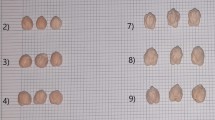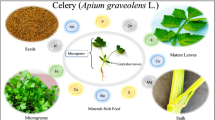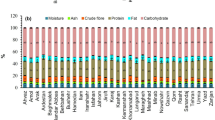Abstract
Four accessions of the lesser-known legume, Cassia obtusifolia L. (Sickle pod), collected from four different agroclimatic regions of Western Ghats, were evaluated for agrobotanical traits and chemical composition. Amongthe four accessions, the Keriparai accession had the highest values for plant height (cm), number of flowers per cluster, number of pods per cluster, pod length (cm), seeds per pod, seed weight (g) per pod and seed recovery percentage. Crude protein ranged from 18.56–22.93%, crude lipid was between 5.35–7.40%, crude fiber ranged from 6.83–9.45%, ash content ranged from 5.14–5.83% and carbohydrate varied from 57.00–60.69%. Globulins constituted the bulk of the seed protein as in most legumes. Mineral profiles, viz., sodium, potassium, calcium, magnesium, phosphorus, iron, copper, zinc and manganese ranged from 42.92–84.83, 758.05–1555.79, 559.92–791.72, 456.36–709.47, 629.13–947.79, 8.42–12.35, 0.93–2.06, 10.60–30.04 and 2.12–4.12 Mg/100 g seeds flour, respectively. Seed proteins of all accessions exhibited relatively high levels of non-essential and essential amino acids, with the exception of threonine. The in vitro protein digestibility of the legume ranged from 74.66 to 81.44%. Antinutritional substances such as total free phenolics ranged from 0.34–0.66%; tannins were between 0.47–0.60%, L-DOPA content ranged from 0.98–1.34%; trypsin inhibitor activity varied from 11.4–13.5 TIU/mg protein and chymotrypsin inhibitor activity ranged from 10.8–12.3 CIU/mg protein. Phytohemagglutinating activity also was assayed. Inconclusion, the accessions of C. obtusifolia, collected from Western Ghats, South India, could serve as a low-cost source of some important nutrients for humans. The antinutritional factors might have little nutritional significance, if the seeds are processed properly.
Similar content being viewed by others
References
Gadgil M (1996) Documenting diversity: An experiment. Curr Sci 70: 36–44.
Sastry ARK, Sharma BD (1991) The significance of Western Ghats in plant conservation. In: Karunakaran CK (ed), The Proceedings of the Symposium on Rare, Endangered and Endemic Plants of theWestern Ghats. Trivandram, India: Kerala Forest Department.
Singh HB, Arora RK (1978) Wild Edible Plants of India. New Delhi, India: ICAR.
Vadivel V, Janardhanan K (1998) Genetic resources of some South Indian tribal pulses. IPGRI Newslett Asia Pacific Oceania 26: 21–22.
Balogun AM, Fetuga BL (1986) Chemical composition of some under-exploited leguminous crop seeds in Nigeria. J Agric Food Chem 34: 189–192.
Siddhuraju P, Vijayakumari K, Janardhanan K (1995) Nutritional and antinutritional properties of the under-exploited legumes Cassia laevigata Wild. and Tamarindus indica L. J Food Comp Anal 8: 351–362.
Siddhuraju P, Vijayakiunari K, Janardhanan K (1993) Genetic resources of tribal pulses. FAO/IPGRI Plant Genet Resour Newslett 96: 47–49.
Singh V, Premanath RK (1992) Some useful Cassia in India. J Econ Tax Bot 10: 29–54.
Crawford L, McDonald GM, Friedman M (1990) Composition of sicklepod (Cassia obtusifolia) toxic weed seeds. J Agric Food Chem 38: 2169–2175.
Gunjatkar N, Vartak VD (1982) Enumeration of wild edible legumes from Pune district, Maharashtra State. J Econ Tax Bot 3: 1–9.
Humphries EC (1956) Mineral components and ash analysis. In: Paech K, Tracey MV (eds), Modern Methods of Plant Analysis. Vol. 1. Berlin: Springer Verlag, pp 469–502.
AOAC (1970) Official Methods of Analysis, 11th edn. Washington, DC: Association of Official Analytical Chemists.
Muller HG, Tobin G (1980) Nutrition and Food Processing. London: Croom Helm Ltd.
Issac RA, Johnson WC (1975) Collaborative study of wet and dry ashing techniques for the elemental analysis of plant tissue by Atomic Absorption Spectrophotometer. J AOAC 58: 436–440.
Dickman SR, Bray RH (1940) Colorimetric determination of phosphate. Ind Eng Chem Anal Ed 12: 665–668.
Basha SMM, Cherry JP, Young CT (1976) Changes in free amino acids, carbohydrates and proteins of maturing seeds from various peas (Arachis hypogaea) cultivars. Cereal Chem 53: 583–597.
Lowry OH, Rosebrough NJ, Farr AL, Randall RJ (1951) Protein measurement with the folin-phenol reagent. J Biol Chem 193: 265–275.
Murray DR (1979) The seed protein of kowhai, Sophora microphylla AIT. Z Pflanzenphysiol 93: 423–428.
Rajendra W (1987) High performance liquid chromatographic determination of amino acids in biological samples by precolumn derivatization with O-phthaldialdehyde. J Liq Chromatogr 10: 941–945.
FAO/WHO (1991) Protein Quality Evaluation. Rome, Italy: Food and Agriculture Organization of the United Nations, p 66.
Ilsu IIW, Vavak DL, Satterlee LD, Miller GA (1977) A multienzyme technique for estimating protein digestibilily. J Food Sci 42: 1269–1271.
Bray KR, Thorne WV (1954) Analysis of phenolic compounds. Meth Biochem Anal 1: 27–52.
Burns RR (1971) Methods for estimation of tannins in gram, Sorghum. Agron J 63: 511–512.
Brain KR (1976) Accumulation of L-DOPA in cultures from Mucuna pruriens. Plant Sci Lett 7: 157–161.
Kakade ML, Rackis JJ, McGhee JE, Puski G (1974) Determination of trypsin inhibitor activity of soy products: A collaborative analysis of an improved procedure. Cereal Chem 51: 376–382.
Kakade ML, Swenson DH, Liener IE (1970) Note on the determination of chymotrypsin and chymotrypsin inhibitor activity using casein. Anal Biochem 33: 255–258.
Liener IE (1976) Phytohaemagglutinins (phytolectins). Ann Rev Plant Physiol 27: 291–319.
Narasinga Rao BS, Deosthale YG, Pant KC (1989) Nutritive Value of Indian Foods. Hyderabad, India: Indian Council of Medical Research, National Institute of Nutrition.
Meiners CR, Derise NL, Lau IIC, Ritchey SJ, Murphy EW (1976) Proximate composition and yield of raw and cooked mature dry legumes. J Agric Food Chem 24: 1122–1126.
Boulter D, Derbyshire D (1976) The general properties, classification and distribution of plant proteins. In: Norton G (ed), Plant Proteins. London: Butterworths, pp 3–24.
Vadivel V, Janardhanan K, Vijayakumari K (1997) Diversity in agrobotanical, nutritional and antinutritional compounds in the germplasm of Cassia occidentalis L. collected from Tamil Nadu, India. Acta Bot Indica 25: 55–60.
Ukhun ME, Ifebigh EO (1988) Compositional chemistry of Cassia alata seeds. Food Chem 30: 205–210.
Meiners CR, Derise NL, Lau HC, Crews MG, Ritchey SJ, Murphy EW (1976) The content of nine mineral elements in raw and cooked mature dry legumes. J Agric Food Chem 24: 1126–1130.
Omode AA, Fatoki OS, Olaogun KA (1995) Physiochemical properties of some underexploited and unconventional oilseeds. J Agric Food Chem 43: 2850–2853.
Vijayakumari K, Siddhuraju P, Janardhanan K (1993) Nutritional and anti-nutritional properties of under-exploited legume seeds. Intl J Food Sci Nutr 44: 181–189.
Singh U (1993) Protein quality of pigeonpea (Cajanus cajan (L.) Millsp) as influenced by seed polyphenols and cooking process. Plant Food Hum Nutr 43: 171–179.
Singh U, Eggum BO (1984) Factors affecting the protein quality of pigeonpea (Cajanus cajan L.). Plant Food Hum Nutr 34: 273–283.
Rani N, Hira CK (1998) Effect of different treatments on chemical constituents of mash beans (Vigna mungo). J Food Sci Technol 35: 540–542.
Uzogara SG, Morton ID, Daniel JW (1990) Changes in some antinutrients of cowpeas (Vigna unguiculata) processed with 'kanwa' alkaline salt. Plant Food Hum Nutr 40: 249–258.
Mohamed AI, Rangappa M (1992) Screening soybean (grain and vegetable) genotypes for nutrients and anti-nutritional factors. Plant Food Hum Nutr 42: 87–96.
Antunes PL, Sgarbieri VC (1980) Effect of heat treatment on the toxicity and nutritive value of dry bean (Phaseolus vulgaris var. Rosinha G2) proteins. J Agric Food Chem 28: 935–938.
Liener IE (1994) Implications of antinutritional components in soybean foods. CRC Crit Rev Food Sci Nutr 34: 31–67.
Mohan VR, Janardhanan K (1995) Chemical determination of nutritional and antinutritional properties in tribal pulses. J Food Sci Technol 32: 465–469.
Siddhuraju P, Vijayakiunari K, Janardhanan K (1996) Chemical composition and protein quality of the little-known legume, velvet bean (Mucuna pruriens (L.) DC.). J Agric Food Chem 44: 2636–2641.
Author information
Authors and Affiliations
Rights and permissions
About this article
Cite this article
Vadivel, V., Janardhanan, K. Agrobotanical traits and chemical composition of Cassia obtusifolia L.: A lesser-known legume of the Western Ghats region of South India. Plant Foods Hum Nutr 57, 151–164 (2002). https://doi.org/10.1023/A:1015218512666
Issue Date:
DOI: https://doi.org/10.1023/A:1015218512666




